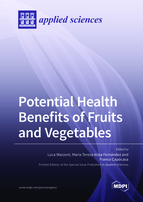Potential Health Benefits of Fruits and Vegetables
A special issue of Applied Sciences (ISSN 2076-3417). This special issue belongs to the section "Food Science and Technology".
Deadline for manuscript submissions: closed (20 April 2021) | Viewed by 43544
Special Issue Editors
Interests: fruits; breeding; diversity; traditional uses; ethnoveterinary; characterization of phytochemicals
Special Issues, Collections and Topics in MDPI journals
Interests: breeding programs; fruit quality; antioxidants; phenolic compounds; antioxidant capacity; bioactive compounds; bioavailability; health-promoting properties
Special Issues, Collections and Topics in MDPI journals
Interests: breeding programs; fruit quality; nursery, rootstock; water management; antioxidant capacity; phenolic compounds
Special Issues, Collections and Topics in MDPI journals
Special Issue Information
Dear Colleagues,
I invite you to contribute to a Special Issue of the journal Applied Sciences, “Potential Health Benefits of Fruits and Vegetables”, which aims to present recent findings on the relationship between fruits and vegetables and the prevention of disease occurrence.
As plant-based foods, both vegetables and fruits have been clearly associated with the presence of high amounts of bioactive compounds, and have been demonstrated as having a central role in the prevention of diseases. Many scientists of different research fields have lavished great effort both to characterize the bioactive compounds’ compositions and to deepen understanding regarding the mechanisms of action through which fruits and vegetables exert their health-promoting and/or disease-preventing properties. In this Special Issue, studies on the bioactive compounds’ composition of the main fruit and vegetable species, on their health effects as fresh-consumed, transformed products or applied in in vitro models, and on their mechanisms of actions against human pathologies will be welcome.
Dr. Luca MazzoniDr. Maria Teresa Ariza Fernández
Prof. Dr. Franco Capocasa
Guest Editors
Manuscript Submission Information
Manuscripts should be submitted online at www.mdpi.com by registering and logging in to this website. Once you are registered, click here to go to the submission form. Manuscripts can be submitted until the deadline. All submissions that pass pre-check are peer-reviewed. Accepted papers will be published continuously in the journal (as soon as accepted) and will be listed together on the special issue website. Research articles, review articles as well as short communications are invited. For planned papers, a title and short abstract (about 100 words) can be sent to the Editorial Office for announcement on this website.
Submitted manuscripts should not have been published previously, nor be under consideration for publication elsewhere (except conference proceedings papers). All manuscripts are thoroughly refereed through a single-blind peer-review process. A guide for authors and other relevant information for submission of manuscripts is available on the Instructions for Authors page. Applied Sciences is an international peer-reviewed open access semimonthly journal published by MDPI.
Please visit the Instructions for Authors page before submitting a manuscript. The Article Processing Charge (APC) for publication in this open access journal is 2400 CHF (Swiss Francs). Submitted papers should be well formatted and use good English. Authors may use MDPI's English editing service prior to publication or during author revisions.
Keywords
- Bioactive compounds
- Antioxidants
- Human diseases
- Nutrition
- Vegetables
- Fruit
- Trees
- Plants
- Herbs
- Breeding
- Vitamins
- Polyphenols
- Antinutrients
- Liquid chromatography
- Gas chromatography
- Spectroscopy
- Immunology
- Biochemistry
- In vitro model
- Pathologies
- In vivo study
- Cell culture
- Animal model
Related Special Issue
- Potential Health Benefits of Fruits and Vegetables II in Applied Sciences (14 articles)








